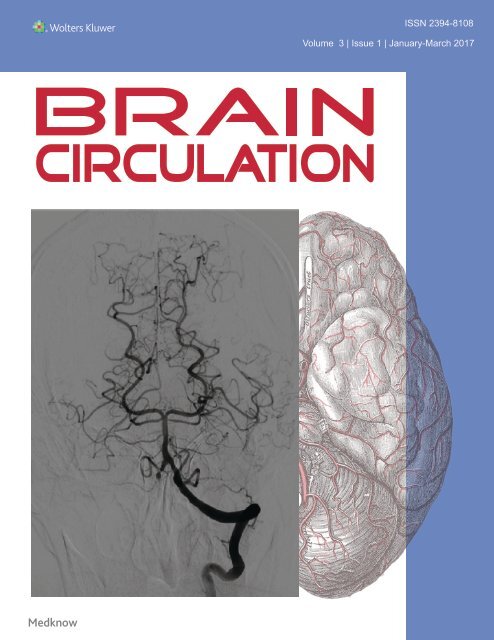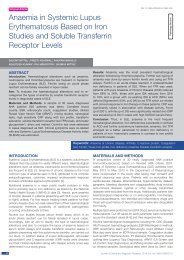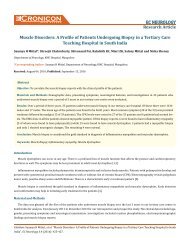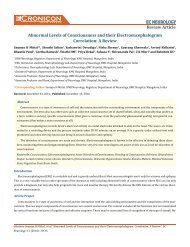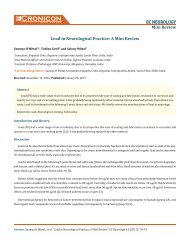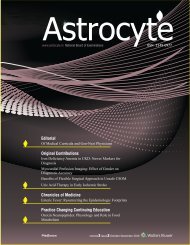Mortality in ischemic stroke score
Create successful ePaper yourself
Turn your PDF publications into a flip-book with our unique Google optimized e-Paper software.
ISSN 2394-8108<br />
Volume 3 | Issue 1 | January-March 2017
Orig<strong>in</strong>al Article<br />
Access this article onl<strong>in</strong>e<br />
Quick Response Code:<br />
<strong>Mortality</strong> <strong>in</strong> <strong>ischemic</strong> <strong>stroke</strong> <strong>score</strong>:<br />
A predictive <strong>score</strong> of mortality for<br />
acute <strong>ischemic</strong> <strong>stroke</strong><br />
Saumya H Mittal 1,2 , Deepak Goel 2<br />
Website:<br />
http://www.bra<strong>in</strong>circulation.org<br />
DOI:<br />
10.4103/2394-8108.203256<br />
Abstract:<br />
OBJECTIVE: This prospective study was planned to formulate and evaluate a predictive <strong>score</strong> for<br />
<strong>in</strong>‐hospital mortality <strong>in</strong> cases of acute <strong>ischemic</strong> <strong>stroke</strong>.<br />
MATERIALS AND METHODS: In this study, 188 consecutive patients of <strong>ischemic</strong> <strong>stroke</strong> were<br />
<strong>in</strong>cluded over 19 months. Only patients with renal failure and malignancy were excluded from the<br />
study. All patients were subjected to cl<strong>in</strong>ical evaluation along with Glasgow Coma Scale (GCS),<br />
National Institute of Health Science scale (NIHSS) <strong>score</strong>, and modified Rank<strong>in</strong> <strong>score</strong> (mRS).<br />
Investigations total leukocyte count (TLC), capillary blood sugar at admission, high‐sensitivity<br />
C‐reactive prote<strong>in</strong> (HS‐CRP), and tropon<strong>in</strong> I, electrocardiogram, and neuroimag<strong>in</strong>g were performed.<br />
The patients were followed up till their outcome <strong>in</strong> the hospital, and patients who expired were<br />
grouped as “mortality group” and the rest as “discharged group.” One‐way anova analysis was<br />
carried out among the significant parameters to identify <strong>in</strong>dependent predictors of mortality <strong>in</strong> cases<br />
of <strong>ischemic</strong> <strong>stroke</strong>.<br />
RESULTS: After statistical analysis, it was found that late presentation to the hospital,<br />
pyrexia (temperature >99F), low diastolic blood pressure at the time of admission, hypoxia (saturation<br />
of oxygen 15, mRS >3, GCS 200 mg/<br />
dL), raised TLC, and HS‐CRP (>10 mg/L) are positive predictive factors of mortality <strong>in</strong> cases of<br />
<strong>ischemic</strong> <strong>stroke</strong>. Based on the above f<strong>in</strong>d<strong>in</strong>gs, a simple and easily applicable mortality <strong>in</strong> <strong>ischemic</strong><br />
<strong>stroke</strong> (MIS) <strong>score</strong> is developed.<br />
CONCLUSION: This MIS <strong>score</strong> system will help the cl<strong>in</strong>icians <strong>in</strong> better management of the patient<br />
and improved counsel<strong>in</strong>g the relatives of patients with <strong>ischemic</strong> <strong>stroke</strong>.<br />
Keywords:<br />
<strong>Mortality</strong> <strong>in</strong> <strong>ischemic</strong> <strong>stroke</strong> <strong>score</strong> system, mortality <strong>in</strong> <strong>stroke</strong>, mortality <strong>score</strong>, <strong>stroke</strong>‐related death,<br />
<strong>stroke</strong> severity<br />
1<br />
Department of<br />
Neurology, KMC<br />
Hospital, Mangalore,<br />
Karnataka, 2 Department of<br />
Neurology, HIMS Hospital,<br />
Dehradun, Uttarakhand,<br />
India<br />
Address for<br />
correspondence:<br />
Dr. Saumya H Mittal,<br />
Department of Neurology,<br />
KMC Hospital,<br />
Dr. Ambedkar<br />
Circle, Mangalore,<br />
Karnataka, India.<br />
E‐mail: saumyamittal1@<br />
gmail.com<br />
Submission: 21‐08‐2016<br />
Revised: 07-12‐2016<br />
Accepted: 25‐12‐2016<br />
Introduction<br />
Cerebral ischemia is caused by reduction<br />
<strong>in</strong> blood flow last<strong>in</strong>g longer than<br />
several seconds. Acute occlusion of an<br />
<strong>in</strong>tracranial vessel causes reduction <strong>in</strong><br />
blood flow to the bra<strong>in</strong> region it supplies.<br />
The magnitude of flow reduction is a<br />
function of collateral blood flow, and<br />
this depends on <strong>in</strong>dividual vascular<br />
anatomy and the site of occlusion. Sudden<br />
death (i.e., with<strong>in</strong> 1 h of onset of symptoms)<br />
This is an open access article distributed under the terms of<br />
the Creative Commons Attribution-NonCommercial-ShareAlike<br />
3.0 License, which allows others to remix, tweak, and build upon<br />
the work non-commercially, as long as the author is credited and<br />
the new creations are licensed under the identical terms.<br />
For repr<strong>in</strong>ts contact: repr<strong>in</strong>ts@medknow.com<br />
is very rarely due to cerebral <strong>in</strong>farction.<br />
Case fatality rate is about 20% at 1 month<br />
for <strong>stroke</strong> <strong>in</strong> general. In a study conducted<br />
<strong>in</strong> Greece, the most important factors<br />
that were found to affect the prognosis<br />
of a patient <strong>in</strong>clude severity of <strong>stroke</strong>,<br />
commonly measured by National Institute<br />
of Health Science scale (NIHSS), modified<br />
Rank<strong>in</strong> <strong>score</strong> (mRS), and Glasgow Coma<br />
Scale (GCS) <strong>score</strong>s. [1,2]<br />
Majority of acute <strong>stroke</strong> patients have<br />
disorders of glucose metabolism, and <strong>in</strong><br />
How to cite this article: Mittal SH, Goel D. <strong>Mortality</strong><br />
<strong>in</strong> <strong>ischemic</strong> <strong>stroke</strong> <strong>score</strong>: A predictive <strong>score</strong> of mortality<br />
for acute <strong>ischemic</strong> <strong>stroke</strong>. Bra<strong>in</strong> Circ 2017;3:29-34.<br />
© 2017 Bra<strong>in</strong> Circulation | Published by Wolters Kluwer Health – Medknow 29
Mittal and Goel: Predictors of <strong>stroke</strong> mortality<br />
most cases, this fact has been unrecognized. Diabetes<br />
worsens the outcome of acute <strong>stroke</strong>. Hyperglycemia<br />
at any time with<strong>in</strong> the first 48 h from <strong>stroke</strong> onset<br />
is associated with poor outcome <strong>in</strong>dependently of<br />
<strong>stroke</strong> severity, <strong>in</strong>farct volume, diabetes, or age. Acute<br />
hyperglycemia predicts <strong>in</strong>creased risk of <strong>in</strong>‐hospital<br />
mortality after <strong>ischemic</strong> <strong>stroke</strong> <strong>in</strong> nondiabetic patients<br />
and <strong>in</strong>creased risk of poor functional recovery <strong>in</strong><br />
nondiabetic <strong>stroke</strong> survivors. [3‐5]<br />
Inflammatory markers predict <strong>in</strong>cident <strong>ischemic</strong> events,<br />
<strong>in</strong>clud<strong>in</strong>g myocardial <strong>in</strong>farction and <strong>stroke</strong>. Levels of<br />
high‐sensitivity C‐reactive prote<strong>in</strong> (HS‐CRP), an acute<br />
phase reactant, were strongly associated with <strong>stroke</strong><br />
severity. Because <strong>stroke</strong> severity is also associated with<br />
mortality, it is not surpris<strong>in</strong>g that this marker is also<br />
associated with mortality after <strong>stroke</strong>. [6]<br />
Epidemiology<br />
Cerebrovascular diseases <strong>in</strong>clude devastat<strong>in</strong>g disorders:<br />
<strong>ischemic</strong> <strong>stroke</strong>, hemorrhagic <strong>stroke</strong>, and cerebrovascular<br />
anomalies such as <strong>in</strong>tracranial aneurysms and<br />
arteriovenous malformations. [7]<br />
Stroke burden <strong>in</strong> India has risen <strong>in</strong> the last few decades<br />
while it reached a plateau or decreased <strong>in</strong> developed<br />
countries. The average annual <strong>in</strong>cidence of <strong>stroke</strong> <strong>in</strong><br />
India is higher than Western nations at 145/100,000<br />
populations. Up to 80% <strong>stroke</strong>s <strong>in</strong> India are <strong>ischemic</strong><br />
<strong>in</strong> nature. [8,9] <strong>Mortality</strong> after <strong>stroke</strong> is high, with <strong>stroke</strong><br />
ranked as the second most common s<strong>in</strong>gle cause of<br />
death <strong>in</strong> the developed world. [10] Of a total of 9.4 million<br />
deaths <strong>in</strong> India, 619,000 deaths are due to <strong>stroke</strong>. This<br />
gives <strong>stroke</strong> a mortality rate of 73/100,000 (estimated<br />
total population 849 million). Approximately 8%–12% of<br />
<strong>ischemic</strong> <strong>stroke</strong>s are fatal (37%–38% hemorrhagic <strong>stroke</strong>s<br />
are fatal). On the other hand, <strong>stroke</strong> decl<strong>in</strong>ed from the<br />
third to the fourth lead<strong>in</strong>g cause of death <strong>in</strong> the United<br />
States recently. [11]<br />
Early prediction of severe disease and high mortality<br />
<strong>in</strong> cases of <strong>stroke</strong> is important for management and<br />
realistic prognostication of patient’s relatives. For<br />
hemorrhagic <strong>stroke</strong>, <strong>in</strong>tracerebral hemorrhage (ICH)<br />
scor<strong>in</strong>g system has a good predictive value for<br />
mortality. [12] This study was planned to f<strong>in</strong>d out various<br />
predictors of early death and if possible development<br />
of a scor<strong>in</strong>g system to predict risk of <strong>in</strong>‐hospital<br />
mortality. This scor<strong>in</strong>g system, such as ICH <strong>score</strong>, will<br />
help cl<strong>in</strong>icians <strong>in</strong> early prediction of <strong>in</strong>‐hospital death<br />
<strong>in</strong> cases of <strong>ischemic</strong> <strong>stroke</strong>.<br />
Materials and Methods<br />
The prospective observational study was carried out<br />
over a period of 19 months after approval from the<br />
Ethics Committee. All consecutive patients of acute<br />
<strong>ischemic</strong> <strong>stroke</strong> of age >18 years were <strong>in</strong>cluded <strong>in</strong> this<br />
observational study. After <strong>in</strong>clusion, each patient was<br />
subjected to a detailed history and cl<strong>in</strong>ical evaluation.<br />
The time of onset of the <strong>stroke</strong> was def<strong>in</strong>ed as the time<br />
when the patient or observer first became aware of the<br />
symptoms. The patients were assessed as per the GCS,<br />
NIHSS <strong>score</strong>, and mRS. The patients were subjected to a<br />
computerized tomogram or magnetic resonance imag<strong>in</strong>g<br />
and blood <strong>in</strong>vestigations hematological, biochemical,<br />
and high sensitive CRP (HS‐CRP). Subsequently, the<br />
patients were treated accord<strong>in</strong>g to the standard treatment<br />
protocols as per American Academy of Neurology<br />
guidel<strong>in</strong>es, year 2007. The study <strong>in</strong> no way <strong>in</strong>terfered<br />
with the treatment. Types of <strong>stroke</strong> were classified<br />
accord<strong>in</strong>g to TOAST classification. [13] All tests and<br />
exam<strong>in</strong>ation were done at admission and with<strong>in</strong> 12 h<br />
from the onset of <strong>stroke</strong>.<br />
The patients were followed up till their outcome <strong>in</strong> the<br />
hospital, and patients who expired were grouped as<br />
“mortality group” and the rest as “discharged group.”<br />
In‐hospital mortality was def<strong>in</strong>ed as death with<strong>in</strong> 30 days<br />
of admission, which is used both <strong>in</strong> Medicare <strong>Mortality</strong><br />
Predictive System and <strong>in</strong> Medicare Hospital <strong>Mortality</strong><br />
Information 1986. [1]<br />
Patients with renal failure and malignancy were<br />
excluded from the study.<br />
Factors compared between two groups were duration of<br />
time between the onset of symptoms and presentation<br />
to the hospital, history of a previous <strong>stroke</strong> or transient<br />
<strong>ischemic</strong> attack, NIHSS, mRS, and GCS <strong>score</strong> at the<br />
time of admission, blood pressure at the time of<br />
admission, temperature at the time of admission,<br />
mean read<strong>in</strong>g of oxygen saturation for 10 m<strong>in</strong> at the<br />
time of admission, random blood sugar (RBS) at the<br />
time of admission, electrocardiogram at the time<br />
of admission, total leukocyte count at the time of<br />
admission, serum potassium at the time of admission,<br />
radiological imag<strong>in</strong>g at the time of admission, HS-CRP<br />
levels at admission, and tropon<strong>in</strong> I levels at the time<br />
of admission.<br />
The f<strong>in</strong>d<strong>in</strong>gs of GCS, NIHSS, mRS, RBS, and HS‐CRP<br />
at admission were divided <strong>in</strong>to three scales, <strong>score</strong> of<br />
1 for best and <strong>score</strong> of 3 for worst f<strong>in</strong>d<strong>in</strong>g [Table 1].<br />
Based on this system, each patient was given one<br />
mortality <strong>in</strong> <strong>ischemic</strong> <strong>stroke</strong> (MIS) <strong>score</strong>, and outcome<br />
was predicted and recorded.<br />
Interpretation and analysis of the obta<strong>in</strong>ed results were<br />
carried out us<strong>in</strong>g one‐way ANOVA statistical tests of<br />
significance us<strong>in</strong>g SPSS 11 (SPSS Inc. Chicago, USA),<br />
Chi‐square test, and Pearson correlation coefficient.<br />
30 Bra<strong>in</strong> Circulation - Volume 3, Issue 1, January-March 2017
Mittal and Goel: Predictors of <strong>stroke</strong> mortality<br />
Results<br />
The study <strong>in</strong>cluded 188 patients (126 male, mean age of<br />
58.3 years ± 13.3) over a period of 19 months. Among<br />
these, 47 (25%) patients expired whereas 141 (75%)<br />
patients survived up to 30 days of <strong>stroke</strong>. All patients<br />
<strong>in</strong> mortality group expired dur<strong>in</strong>g the first admission,<br />
and none of the discharged patients expired with<strong>in</strong><br />
1 months. Among all, 166 (88.2%) patients had TOAST<br />
type 1 <strong>stroke</strong> (large artery atherosclerotic). Different<br />
parameters among two groups are described <strong>in</strong> Table 1.<br />
The f<strong>in</strong>d<strong>in</strong>gs of one‐way ANOVA test applied on the<br />
cohort are given <strong>in</strong> Table 2.<br />
The average duration from the onset of symptoms<br />
of <strong>stroke</strong> to the presentation at the hospital was<br />
47.510 ± 39.727 h <strong>in</strong> mortality group compared to<br />
22.553 ± 43.067 h <strong>in</strong> discharged group (P = 0.006).<br />
All of the 188 patients were assessed as per the NIHSS<br />
<strong>score</strong> at the time of admission. The mean NIHSS<br />
<strong>score</strong> <strong>in</strong> the mortality group was 32.659 ± 0.938. The<br />
mean NIHSS <strong>score</strong> <strong>in</strong> the discharged group was<br />
22.269 ± 4.878 (P = 0.0001).<br />
All of the 47 patients were admitted <strong>in</strong> the severe<br />
category as per the mRS system, and only 23 (16.3%)<br />
among discharged group presented with the severe<br />
<strong>score</strong> (<strong>score</strong> of 5). The mean mRS <strong>score</strong> <strong>in</strong> the mortality<br />
group is 5 ± 0 while the mean mRS <strong>score</strong> <strong>in</strong> the patients<br />
that were discharged was 4.014 ± 0.609 (P = 0.0001).<br />
All of the 47 patients were <strong>in</strong> the severe category of GCS<br />
<strong>score</strong>s (3–8). On the other hand, <strong>in</strong> the discharged group,<br />
Table 1: Comparison of basic parameters <strong>in</strong> two<br />
groups<br />
Criteria<br />
<strong>Mortality</strong> Group<br />
N=47<br />
Morbidity group<br />
N=141<br />
Mean so Mean so<br />
Demographic<br />
Age (yrs) 56.00 13.00 59.01 13.35<br />
M/F 36/11 90/51<br />
Exam<strong>in</strong>ation<br />
NIHSS 32.66 0.94 22.27 4.88<br />
MRS 5.00 0.00 4.01 0.61<br />
GCS 3.79 0.95 11.30 2.86<br />
SBP(mm H g) 130.21 42.86 135.60 24.06<br />
(mm Hg) 75.53 29.18 82.06 14.32<br />
Temp (F) 98.60 0.90 98.50 0.70<br />
Investigation<br />
RBS (mg/Q!,) 184.53 83.66 149.29 71.38<br />
SPo 2<br />
(%) 93.00 6.00 97.00 5.00<br />
TLC (/cmm) 15258.51 6951.62 11475.12 4954.69<br />
K (mEq /l) 4.42 0.70 4.12 0.63<br />
HSCRP (mg/L) 13.82 4.18 4.76 4.36<br />
twenty patients were <strong>in</strong> the severe category (3–8) at the<br />
time of admission, 84 patients were <strong>in</strong> the moderately<br />
severe category (9–12), and the rema<strong>in</strong><strong>in</strong>g 37 patients were<br />
<strong>in</strong> the mild category (13–15) as per the GCS (P = 0.0001).<br />
Mean GCS <strong>in</strong> mortality group (3.787) was significantly<br />
low <strong>in</strong> comparison of other group (11.3) (P = 0.0001).<br />
The RBS at the time of admission, irrespective to diabetic<br />
status, was found to higher <strong>in</strong> expired group. The mean<br />
RBS of the patients who expired was 184.53 ± 83.66 mg/<br />
dl (10.26 mmol/L) compared to 149.29 ± 71.38 mg/<br />
dl (8.26 mmol/L) <strong>in</strong> discharged patients (P = 0.0001).<br />
Among patients who expired, forty of the 47 had a HS‐CRP<br />
level of more than 10 mg/L and 7 had levels ≤10 mg/L.<br />
In contrast, 25 patients of the 141 patients who were<br />
discharged had HS‐CRP levels of more than 10 mg/L.<br />
One hundred and sixteen patients of the 144 patients<br />
that were discharged had HS‐CRP levels of ≤10 mg/L.<br />
The mean of HS‐CRP levels of patients who expired was<br />
13.82 ± 4.18 mg/L, while that of the patients who were<br />
discharged was 4.76 ± 4.36 mg/L (P = 0.0001). The above<br />
f<strong>in</strong>d<strong>in</strong>gs are summarized <strong>in</strong> Tables 1, 2, and 5.<br />
None of our patients underwent craniectomy.<br />
Distribution of all 188 patients accord<strong>in</strong>g to the different<br />
MIS <strong>score</strong>s [Table 3] is given <strong>in</strong> Table 4. Accord<strong>in</strong>gly,<br />
we have 102 (54.3%) patients with <strong>score</strong> of
Mittal and Goel: Predictors of <strong>stroke</strong> mortality<br />
Table 2: Anova test f<strong>in</strong>d <strong>in</strong>gs <strong>in</strong> two groups<br />
Sum of squares df Mean square F Significance (P )<br />
RBS<br />
Between Groups 43444.149 1 43444.149 7.842 0.006<br />
With<strong>in</strong> Groups 1030426.170 186 5539.926<br />
Total 1073870.319 187<br />
GCS<br />
Between Groups 1992.199 1 1992.192 312.499 0.0001<br />
With<strong>in</strong> Groups 1185.759 186 6.375<br />
Total 3177.957 187<br />
NIHSS<br />
Between Groups 3794.980 1 3794.98 206.442 0.0001<br />
With <strong>in</strong> Groups 3419.206 186 18.383<br />
Total 7214.196 187<br />
mRS<br />
Between Groups 34.257 134.257 34.257 122.602 0.0001<br />
With <strong>in</strong> Groups 51.972 186 18.383<br />
Total 86.229 187<br />
HS CRP<br />
Between Groups 2896.347 1 2896.347 155.051 0.0001<br />
With<strong>in</strong> Groups 3474.480 186 18.68<br />
Total 6370.827 187<br />
Age<br />
Between Groups 262.810 1 262.81 1.49 0.224<br />
With<strong>in</strong> Groups 32815.716 186 176.429<br />
Total 33078.527 187<br />
Type<br />
Between Groups 0.028 1 0.028 0.04 0.842<br />
With <strong>in</strong> Groups 131.716 186 0.708<br />
Total 131.745 187<br />
Time<br />
Between Groups 21956.314 1 21956.314 12.291 0.001<br />
With <strong>in</strong> Groups 223370.596 186 1786.401<br />
Total 354226.910 187<br />
Temp<br />
Between Groups 1.512 1 1.512 2.87 0.092<br />
With<strong>in</strong> Groups 97.975 186 0.527<br />
Total 99.486 187<br />
SP0 2<br />
Between Groups 453.965 1 453.965 17.312 0.0001<br />
With<strong>in</strong> Groups 4877.504 186 26.233<br />
Total 5331.468 187<br />
SBP<br />
Between Groups 42.598 1 42.598 0.06 0.807<br />
With <strong>in</strong> Groups 132716.312 186 713.529<br />
Total 132758.910 187<br />
DBP<br />
Between Groups 181.560 1 181.560 0.715 0.399<br />
With <strong>in</strong> Groups 47201.418 186 253.771<br />
Total 47382.979 187<br />
IHD<br />
Between Groups 0.064 1 0.064 2.067 0.152<br />
With<strong>in</strong> Groups 5.745 186 0.031<br />
Total 5.809 187<br />
TLC<br />
Between Groups 504569925.114 1 504569925.114 16.582 0.0001<br />
With<strong>in</strong> Groups 5659805424.696 186 30429061.42<br />
Total 6166375349.809 187<br />
32 Bra<strong>in</strong> Circulation - Volume 3, Issue 1, January-March 2017
Mittal and Goel: Predictors of <strong>stroke</strong> mortality<br />
Table 2: Contd...<br />
Sum of squares df Mean square F Significance (P )<br />
K<br />
Between Groups 3.001 1 3.001 7.115 0.008<br />
With <strong>in</strong> Groups 78.014 185 0.422<br />
Total 81.015 186<br />
Table 3: Parameters selected for scor<strong>in</strong>g system<br />
SN Parameters Score 1 for each Score 2 for each Score 3 for each<br />
1 NIHSS 0-5 6-14 >15<br />
2 mRS 0-2 3-4 5<br />
3 GCS 13-15 9-12 3-8<br />
4 Random glucose at admissiom 200<br />
5 HS-CRP 15<br />
M<strong>in</strong>imum to Maximum <strong>score</strong> 5 10 15<br />
Table 4: Distribution of all patients accord<strong>in</strong>g to<br />
various scales<br />
Score Number of patients Deaths<br />
5-6 0 0<br />
7-8 20 0<br />
9-10 82 0<br />
11-12 37 5 (13.5%)<br />
13 26 19 (73%)<br />
14 18 18 (100%)<br />
15 5 5 (100%)<br />
Table 5: P values of significant f<strong>in</strong>d<strong>in</strong>gs<br />
Factor<br />
P<br />
Onset to Presentat on Duration 0.006<br />
NIHSS <strong>score</strong> at Admission 0.0001<br />
MRS <strong>score</strong> at Admission 0.0001<br />
GCS <strong>score</strong> at Admission 0.0001<br />
RBS at Admission 0.0001<br />
HS CRP at Admission 0.0001<br />
propose a new system for predict<strong>in</strong>g <strong>in</strong>-hospital mortality<br />
of patients suffer<strong>in</strong>g from <strong>ischemic</strong> <strong>stroke</strong>, titled as<br />
<strong>Mortality</strong> <strong>in</strong> Ischemic Stroke “MIS” <strong>score</strong>. A <strong>score</strong> of 14 with worst <strong>in</strong> <strong>ischemic</strong> <strong>stroke</strong>. [15,16]<br />
In our study, 25% patients expired dur<strong>in</strong>g hospital<br />
admission after acute <strong>ischemic</strong> <strong>stroke</strong> that was<br />
higher as compared to Western data (Northern<br />
Manhattan Stroke Study, 2001, found a mortality of<br />
5% at 1 month) but similar to another Indian study.<br />
In‐hospital mortality is related to <strong>stroke</strong> severity and<br />
related complications. [10,11] That is why three of our<br />
parameters <strong>in</strong> scor<strong>in</strong>g system were related to cl<strong>in</strong>ical<br />
severity ‐ NIHSS, mRS, and GCS ‐ that are directly<br />
l<strong>in</strong>ked to early deaths <strong>in</strong> <strong>ischemic</strong> <strong>stroke</strong>. NIHSS<br />
more than 15, mRS more than 3, and GCS
Mittal and Goel: Predictors of <strong>stroke</strong> mortality<br />
<strong>stroke</strong> society. Multivariable predictors of 30‐day and<br />
1‐year mortality <strong>in</strong>cluded older age, male sex, severe<br />
<strong>stroke</strong>, nonlacunar <strong>stroke</strong> subtype, glucose ≥7.5<br />
mmol/L (135 mg/dL), history of atrial fibrillation,<br />
coronary artery disease, congestive heart failure, cancer,<br />
dementia, kidney disease on dialysis, and dependency<br />
before the <strong>stroke</strong>. Based on these factors, a risk <strong>score</strong><br />
<strong>in</strong>dex stratified the risk of death at 30 days and 1 year<br />
and identified low‐ and high‐risk <strong>in</strong>dividuals. [24] This<br />
system <strong>in</strong>cludes all parameters for short as well as<br />
long‐term mortality, so it is more extensive and therefore<br />
little lengthy for bedside utility and is more useful for<br />
long‐term mortality.<br />
The mortality <strong>in</strong> <strong>ischemic</strong> <strong>stroke</strong> <strong>score</strong> (MISS) system<br />
is applicable for prediction of <strong>in</strong>‐hospital mortality <strong>in</strong><br />
<strong>stroke</strong> patients at presentation. It is short, simple, and<br />
easy to apply as it uses bedside cl<strong>in</strong>ical scales and simple<br />
<strong>in</strong>vestigations whose results are quickly available. The<br />
selected parameters for MISS are related to cl<strong>in</strong>ical<br />
severity of <strong>stroke</strong> and are helpful for early prediction of<br />
MIS. The radiological assessment of bra<strong>in</strong> parenchyma<br />
<strong>in</strong>volvement is not relied upon s<strong>in</strong>ce different recoveries<br />
with similar parenchyma <strong>in</strong>volvement have been noted.<br />
Besides size of the <strong>in</strong>farct may not accurately def<strong>in</strong>e, the<br />
severity as a small‐sized <strong>in</strong>farct <strong>in</strong> a crucial area may<br />
do more harm than a large <strong>in</strong>farct <strong>in</strong> a relatively less<br />
critical area.<br />
Conclusion<br />
Our MIS system can effectively predict the mortality <strong>in</strong><br />
patients with <strong>ischemic</strong> <strong>stroke</strong> at the time of presentation<br />
and thereby help physicians and neurologists predict<br />
the outcome of patients at the presentation to the<br />
hospital.<br />
F<strong>in</strong>ancial support and sponsorship<br />
Nil.<br />
Conflicts of <strong>in</strong>terest<br />
There are no conflicts of <strong>in</strong>terest.<br />
References<br />
1. Jencks SF, Daley J, Draper D, Thomas N, Lenhart G, Walker J.<br />
Interpret<strong>in</strong>g hospital mortality data. The role of cl<strong>in</strong>ical risk<br />
adjustment. JAMA 1988;260:3611‐6.<br />
2. Vemmos KN, Bots ML, Tsibouris PK, Zis VP, Takis CE,<br />
Grobbee DE, et al. Prognosis of <strong>stroke</strong> <strong>in</strong> the South of Greece: 1 year<br />
mortality, functional outcome and its determ<strong>in</strong>ants: The Arcadia<br />
Stroke Registry. J Neurol Neurosurg Psychiatry 2000;69:595‐600.<br />
3. Matz K, Keresztes K, Tatschl C, Nowotny M, Dachenhausen A,<br />
Bra<strong>in</strong><strong>in</strong> M, et al. Disorders of glucose metabolism <strong>in</strong> acute<br />
<strong>stroke</strong> patients: An underrecognized problem. Diabetes Care<br />
2006;29:792‐7.<br />
4. Fuentes B, Castillo J, San José B, Leira R, Serena J, Vivancos J, et al.<br />
The prognostic value of capillary glucose levels <strong>in</strong> acute <strong>stroke</strong>:<br />
The GLycemia <strong>in</strong> acute <strong>stroke</strong> (GLIAS) study. Stroke 2009;40:562‐8.<br />
5. Capes SE, Hunt D, Malmberg K, Pathak P, Gerste<strong>in</strong> HC. Stress<br />
hyperglycemia and prognosis of <strong>stroke</strong> <strong>in</strong> nondiabetic and<br />
diabetic patients: A systematic overview. Stroke 2001;32:2426‐32.<br />
6. Elk<strong>in</strong>d MS, Tai W, Coates K, Paik MC, Sacco RL. High‐sensitivity<br />
C‐reactive prote<strong>in</strong>, lipoprote<strong>in</strong>‐associated phospholipase A2, and<br />
outcome after <strong>ischemic</strong> <strong>stroke</strong>. Arch Intern Med 2006;166:2073‐80.<br />
7. Smith WS, English JD, Claiborne Johnston S. Cerebrovascular<br />
diseases. In: Fauci Anthony S, Eugene B, Kasper Dennis L,<br />
Hauser Stephen L, Longo Dan L, Larry JJ, et al., editors.<br />
Harrison’s Pr<strong>in</strong>ciples of Internal Medic<strong>in</strong>e. 17 th ed. New York:<br />
The McGraw‐Hill Companies, Inc.; 2008. p. 2513‐36.<br />
8. Kaul S, Bandaru VC, Suvarna A, Boddu DB. Stroke burden and<br />
risk factors <strong>in</strong> develop<strong>in</strong>g countries with special reference to India.<br />
J Indian Med Assoc 2009;107:358, 367‐70.<br />
9. Ll<strong>in</strong>as Rafael H. Overview of the approach to the <strong>stroke</strong> patient.<br />
In: Wityk Robert J, Ll<strong>in</strong>as Rafael H, editors. Stroke. Mumbai:<br />
Aramuc India Ltd.; 2007. p. 1‐4.<br />
10. Towfighi A, Saver JL. Stroke decl<strong>in</strong>es from third to fourth lead<strong>in</strong>g<br />
cause of death <strong>in</strong> the United States: Historical perspective and<br />
challenges ahead. Stroke 2011;42:2351‐5.<br />
11. Balami JS, Chen RL, Grunwald IQ, Buchan AM. Neurological<br />
complications of acute ischaemic <strong>stroke</strong>. Lancet Neurol<br />
2011;10:357‐71.<br />
12. Hemphill JC 3 rd , Bonovich DC, Besmertis L, Manley GT,<br />
Johnston SC. The ICH <strong>score</strong>: A simple, reliable grad<strong>in</strong>g scale for<br />
<strong>in</strong>tracerebral hemorrhage. Stroke 2001;32:891‐7.<br />
13. Adams HP Jr., Bendixen BH, Kappelle LJ, Biller J, Love BB,<br />
Gordon DL, et al. Classification of subtype of acute <strong>ischemic</strong><br />
<strong>stroke</strong>. Def<strong>in</strong>itions for use <strong>in</strong> a multicenter cl<strong>in</strong>ical trial. TOAST.<br />
Trial of Org 10172 <strong>in</strong> acute <strong>stroke</strong> treatment. Stroke 1993;24:35‐41.<br />
14. Bushnell C. Another <strong>score</strong> to predict <strong>ischemic</strong> <strong>stroke</strong> mortality?<br />
Circulation 2011;123:712‐3.<br />
15. Wong KS. Risk factors for early death <strong>in</strong> acute <strong>ischemic</strong> <strong>stroke</strong> and<br />
<strong>in</strong>tracerebral hemorrhage: A prospective hospital‐based study <strong>in</strong><br />
Asia. Asian Acute Stroke Advisory Panel. Stroke 1999;30:2326‐30.<br />
16. Heuschmann PU, Kolom<strong>in</strong>sky‐Rabas PL, Misselwitz B,<br />
Hermanek P, Leffmann C, Janzen RW, et al. Predictors of<br />
<strong>in</strong>‐hospital mortality and attributable risks of death after <strong>ischemic</strong><br />
<strong>stroke</strong>: The German Stroke Registers Study Group. Arch Intern<br />
Med 2004;164:1761‐8.<br />
17. Bhatia RS, Garg RK, Gaur SP, Kar AM, Shukla R, Agarwal A,<br />
et al. Predictive value of rout<strong>in</strong>e hematological and biochemical<br />
parameters on 30‐day fatality <strong>in</strong> acute <strong>stroke</strong>. Neurol India<br />
2004;52:220‐3.<br />
18. Clark Wayne M, Hourhane Maurice J. Cl<strong>in</strong>ical <strong>stroke</strong> scales.<br />
In: Herndon Robert M, editor. Handbook of Neurologic Rat<strong>in</strong>g<br />
Scales. 2 nd ed. New York: Demos Medical Publish<strong>in</strong>g, Inc.; 2006.<br />
p. 261‐84.<br />
19. Yoneda Y, Uehara T, Yamasaki H, Kita Y, Tabuchi M, Mori E.<br />
Hospital‐based study of the care and cost of acute <strong>ischemic</strong> <strong>stroke</strong><br />
<strong>in</strong> Japan. Stroke 2003;34:718‐24.<br />
20. Sulter G, Steen C, De Keyser J. Use of the Barthel <strong>in</strong>dex and<br />
modified Rank<strong>in</strong> scale <strong>in</strong> acute <strong>stroke</strong> trials. Stroke 1999;30:1538‐41.<br />
21. Hartmann A, Rundek T, Mast H, Paik MC, Boden‐Albala B,<br />
Mohr JP, et al. <strong>Mortality</strong> and causes of death after first <strong>ischemic</strong><br />
<strong>stroke</strong>: The Northern Manhattan <strong>stroke</strong> study. Neurology<br />
2001;57:2000‐5.<br />
22. Wong AA, Read SJ. Early changes <strong>in</strong> physiological variables after<br />
<strong>stroke</strong>. Ann Indian Acad Neurol 2008;11:207‐20.<br />
23. Idicula TT, Brogger J, Naess H, Waje‐Andreassen U, Thomassen L.<br />
Admission C‐reactive prote<strong>in</strong> after acute <strong>ischemic</strong> <strong>stroke</strong> is<br />
associated with <strong>stroke</strong> severity and mortality: The ‘Bergen <strong>stroke</strong><br />
study’. BMC Neurol 2009;9:18.<br />
24. Saposnik G, Kapral MK, Liu Y, Hall R, O’Donnell M, Raptis S, et al.<br />
IScore: A risk <strong>score</strong> to predict death early after hospitalization for<br />
an acute <strong>ischemic</strong> <strong>stroke</strong>. Circulation 2011;123:739‐49.<br />
34 Bra<strong>in</strong> Circulation - Volume 3, Issue 1, January-March 2017


